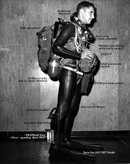You are forgetting the 20-man life raft bottles from the 1950s military surplus that were converted into scuba bottles (at least in the U.S. Air Force). These bottles were wire-wrapped originally, as they were on planes is life raft bundles, and if that plane was hit by bullets, at least the bottle would not explode. We took the wire wrap off them, then sawed off the top (with its outside thread) and tapped them for 1/2 inch tapered threads. I now call these my PJ tanks, as they were our jump tanks in USAF Pararescue. I calculated that they are 42 cubic foot tanks, by comparing the pressure drops with my twin AL 50s when I equilized them (full 3000 psig fill on the AL 50s, to the twin PJ tanks). The calculation came out to about 42 cubic feet at full pressure (2100 psig). I used the formula:
P1V1/T1 = P2V2/T2, and the temperatures cancelled out as the same, so getting volume was:
V2 = P2/(P1V1)
Below you can see Bill Pitsenbarger wearing these tanks.
Today I dived my twin 53s, and I had a great dive, using my Mossback Mk 3 regulator with the setup. I put two 3 pound bullet weights on the back to avoid buoyancy problems (same as I did for the video, "Getting the Lead Out" above). As twins, I really like these tanks.
SeaRat
P1V1/T1 = P2V2/T2, and the temperatures cancelled out as the same, so getting volume was:
V2 = P2/(P1V1)
Below you can see Bill Pitsenbarger wearing these tanks.
Today I dived my twin 53s, and I had a great dive, using my Mossback Mk 3 regulator with the setup. I put two 3 pound bullet weights on the back to avoid buoyancy problems (same as I did for the video, "Getting the Lead Out" above). As twins, I really like these tanks.
SeaRat





